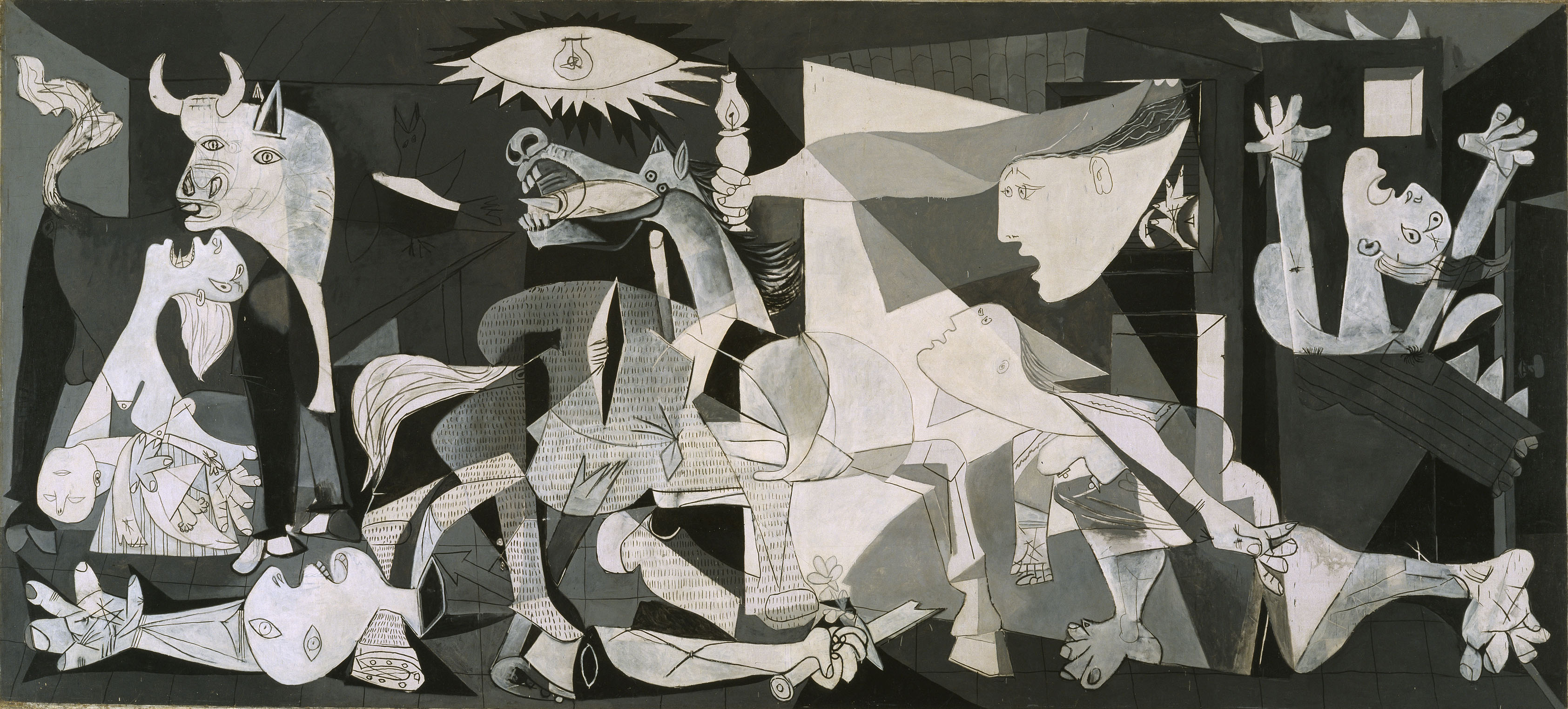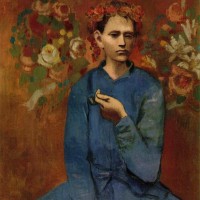| Painting Name | Guernica |
| Painter Name | Pablo Picasso |
| Completion Date | 1937 |
| Place of Creation | France, Paris |
| Size | 349 cm × 776 cm (137.4 in × 305.5 in) |
| Technique | Oil |
| Material | Canvas |
| Current Location | Museo Reina Sofia Madrid Spain |
Guernica is a well-appraised painting by the acclaimed artist Pablo Picasso. This mural sized painting was artist’s reaction to the real life bombing on the town of Guernica in Spain during the Spanish Civil War in 1937. The painting and its world-tour during the year helped largely to bring the world’s attention towards the ongoing civil war and its harsh consequences. Today, the painting has become the anti-war symbol. According to some reviewers, the painting was the greatest accomplishment of Picasso’s career for its impacts on the world about the bombing.
Picasso and his fellows pushed Cubism ahead with entirely accepting the art-movement and the represented art is a piece of cubist art.
The Real Guernica Bombing
Bombing of Guernica happened on 26th April, 1937. The by-air attack was commanded by Italian and German air-forces under the operation called Operation Rügen. Out of the 7000 people living in the town at the time of the bombing, 1654 people were killed according to the government officials. But, real figure of atrocity is believed to be double or maybe triple. Unfortunately, as it was a “market day”, people from the surrounding area were also present in the town taking the whole population present in the town during the day to 10000. Total of 8 air-attacks were executed to demolish the town.
Figures and Objects – Guernica Analysis
There are more than 10 prominent objects included in the painting. Everything is crammed inside a room. Starting from the left, there is a bull standing right over a woman who is crying out loud while holding a dead baby in her hands. Below that there is a spread hand of a man whose head and second hand is on the right side. Above that, in the middle of the painting, is a figure of a horse. The horse is also crying out loud as a spear has just come out of his side. Falling in agony, horse’s one leg is kneed.
Right over the head of the horse is a light-bulb commemorating the lonely bulb in a torture chamber. On the right side of the horse, there are three more figures. A woman’s head is floating in with the expressions of awe and pity on her face as she watches over the brutality taking place in the room. Though, Picasso has tried to add some hope by a making the woman’s hand (similarly floating in the air) hold a lamp. Another feminine figure is under that floating head glancing blankly at the lamp. On the far, right side, a figure is trapped and being devoured into, supposedly, fire. The less clear objects are the open door at the right end of the object and a bird, between the bull and horse’s head.
The Ongoing Symbolism
Chiefly, the painting represents the heartless bombing which explains pretty much everything about the brutality happening inside the room. Each of the objects is the representative of the things ruined in the real scenario. Crying woman and the fallen man represents the humans who got killed. Their postures also include an emotional meaning. The man is fallen, which means there is no one to protect his family. Consequently, the woman has lost her child –representing the sheer and unconscious brutality. And woman is placed under the bull indicating the still-present danger.
Horse is the symbol of a support for man, on which people ride and sometimes, runs away if they finds danger around which is uncontrollable. But, here the horse itself is wounded and has fallen on its knee. It symbolizes the helplessness of the people of Guernica, saying that they had help from nowhere and also few resources they have got to protect themselves were useless or becoming useless by the heavy bombing.
As mentioned before, the light-bulb resembles the lonely bulb in the torture chamber. Though, a logical explanation for its presence in the painting is in the Spanish language. In Spanish, a bulb is called Bombilla, which is very near to the English word Bomb.
The floating women watching over the scene is a bystander of the ongoing Spanish civil war and the lamp in her hand symbolizes the hope. It is smartly placed near the bombilla – symbol of torture and bombs. The on looking woman under the floating head looks at the lamp for her belief of hope. The figure on the far right trapped and crying out loud again represents the trapped situation of the citizens.
The Room of Atrocity
Due to its simple linear style with use of only three colors – Black, white and Grey – it succeeds to create emotions and horrors of the real bombings. The superimposed composition of figures and objects delivers an air of disturbance and havoc.
It is not a realistic painting, which depicts an event just as it looks in the real world. It’s a cubist painting, using symbolism as its backbone to deliver the message. Each object or object group stands for the real-life versions in the real scenario. The whole room is the town of Guernica itself with people, families, outer world and brutal things happenings inside the town.
This, anti-war painting had succeed to grab the attention of the world towards the bombing and consequently impacted on the Spanish Civil war to some extent. It also has encouraged many other painters over the years.
Although, critics and reviewers can interpret logical and rational meanings, Pablo Picasso’s take on such review for the painting was something like this:
“…this bull is a bull and this horse is a horse… If you give a meaning to certain things in my paintings it may be very true, but it is not my idea to give this meaning. What ideas and conclusions you have got I obtained too, but instinctively, unconsciously. I make the painting for the painting. I paint the objects for what they are.”
He was paid 200,000 peseta (Spanish currency) for the painting by Spanish Government at the time.





only painting Picasso gets my claps for due to the message delivered through art…his some works are worse than a first grader’s family paintings